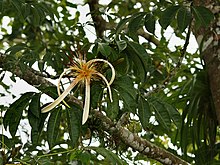Pachira aquatica
| Pachira aquatica | |
|---|---|
 |
|
| Scientific classification | |
| Kingdom: | Plantae |
| (unranked): | Angiosperms |
| (unranked): | Eudicots |
| (unranked): | Rosids |
| Order: | Malvales |
| Family: | Malvaceae |
| Genus: | Pachira |
| Species: | P. aquatica |
| Binomial name | |
|
Pachira aquatica Aubl. |
|
| Synonyms | |
|
Carolinea macrocarpa |
|
Carolinea macrocarpa
Bombax macrocarpum
Bombax glabrum
Pachira macrocarpa
Pachira aquatica is a tropical wetland tree of the mallow family Malvaceae, native to Central and South America where it grows in swamps. It is known by the common names Malabar chestnut, French peanut, Guiana chestnut, provision tree, saba nut, monguba (Brazil), pumpo (Guatemala) and is commercially sold under the names money tree and money plant. This tree is sometimes sold with a braided trunk and is commonly grown as a houseplant, although more commonly what is sold as a "Pachira aquatica" houseplant is in fact a similar species, P. glabra.
Pachira aquatica can grow up to 18 m (59.1 ft) in height in the wild. It has shiny green palmate leaves with lanceolate leaflets and smooth green bark. Its showy flowers have long, narrow petals that open like a banana peel to reveal hairlike yellowish orange stamens. The tree is cultivated for its edible nuts, which grow in a large, woody pod. The nuts are light brown, striped with white. They are said to taste like peanuts, and can be eaten raw, cooked, or ground into flour to make bread. The leaves and flowers are also edible.
The tree grows well as a tropical ornamental in moist, frost-free areas, and can be started from seed or cutting. It is a durable plant and adapts well to different conditions. The pachira needs plenty of sunlight, though it is important to place in direct sunlight gradually in summer months, as the leaves may get sunburned.
The fruit, a nut, is of a brownish colour and can measure up to 12 inches (300 mm) in length and 2.5 inches (64 mm) in diameter. Seeds grow within until such time as the nut bursts, sending the seeds forth and propagating. The nut is edible and often eaten raw or roasted, with a flavor similar to a European chestnut; it may also be ground and made as a hot drink. The fruit is not eaten.
...
Wikipedia
